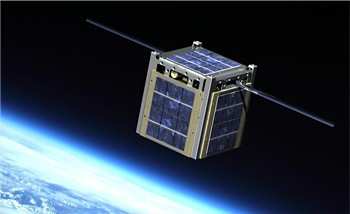Thu, Feb 28, 2013
Twenty-Four Small Satellites Chosen To Fly On Future Missions
NASA has selected 24 small satellites to fly as auxiliary payloads aboard rockets planned to launch in 2014, 2015 and 2016. The proposed CubeSats come from universities across the country, a Florida high school, several non-profit organizations and NASA field centers. CubeSats belong to a class of research spacecraft called nanosatellites. The cube-shaped satellites measure about 4 inches on each side, have a volume of about 1 quart, and weigh less than 3 pounds.

The selections are from the fourth round of the CubeSat Launch Initiative. After launch, the satellites will conduct technology demonstrations, educational research or science missions. The selected CubeSats will be eligible for flight after final negotiations and an opportunity for flight becomes available.
The following organizations submitted winning satellite proposals:
- The Aerospace Corporation, El Segundo, CA.
- The Discovery Museum and Planetarium, Bridgeport, CT.
- Embry-Riddle Aeronautical University, Prescott, AZ.
- Morehead State University, Morehead, KY, in partnership with the University of California at Berkeley
- Montana State University, Bozeman (2 CubeSats) in partnership with The University of New Hampshire, Durham
- Merritt Island High School, Florida, in partnership with California Polytechnic State University, San Luis Obispo
- NASA's Ames Research Center, Moffett Field, CA.
- NASA's Goddard Space Flight Center, Greenbelt, Md. (3 CubeSats)
- NASA's Jet Propulsion Laboratory, Pasadena, CA., in partnership with the California Institute of Technology, Pasadena (3 CubeSats)
- NASA's Kennedy Space Center, Florida
- Pennsylvania State University, in partnership with the Naval Research Laboratory, Monterey, CA., and the Aerospace Corporation, El Segundo, CA.
- Saint Louis University, St. Louis, MO.
- Tyvak Nano-Satellites Systems, Irvine, CA., in partnership with the California Polytechnic State University, San Luis Obispo
- University at Buffalo, The State University of New York
- University of Colorado, Boulder
- University of Florida, Gainesville, in partnership with Stanford University
- University of Maryland, Baltimore County
- University of Texas, Austin
- Vanderbilt University, Nashville, TN, in partnership with the Radio Amateur Satellite Corporation, Silver Spring, MD.
In the three previous rounds of the CubeSat initiative, NASA has selected 63 missions for flight. The agency's Launch Services Program Educational Launch of Nanosatellite (ELaNa) Program has launched 12 CubeSat missions. This year, 22 CubeSat missions are scheduled for flight.
(CubeSat image provided by NASA)
More News
Scheduled for Friday, November 7th at 1800ET, The MOSAIC Town Hall, Webcast At www.airborne-live.net One of the more intriguing features of the 2025 Affordable Flying Expo, schedul>[...]
From 2023 (YouTube Edition): The Mosquito Evolves Formerly known as Mosquito, Trenton, Florida-based Composite FX is a designer and manufacturer of personal kit and factory-finishe>[...]
“The Board is pleased to name Lisa as our next CEO after conducting a comprehensive succession planning process and believes this transition will ensure continued success for>[...]
Ground Stop (GS) The GS is a process that requires aircraft that meet a specific criteria to remain on the ground. The criteria may be airport specific, airspace specific, or equip>[...]
The Airplane Stalled Above The Runway Threshold, The Nose Dropped, The Nose Wheel Impacted The Runway, And The Airplane Flipped Over Analysis: The pilot reported that during the fi>[...]
 Affordable Flying Expo Announces Industry MOSAIC Town Hall
Affordable Flying Expo Announces Industry MOSAIC Town Hall Classic Aero-TV: Composite-FX Sets Elevates the Personal Helicopter Market
Classic Aero-TV: Composite-FX Sets Elevates the Personal Helicopter Market Aero-News: Quote of the Day (10.25.25)
Aero-News: Quote of the Day (10.25.25) ANN's Daily Aero-Term (10.25.25): Ground Stop (GS)
ANN's Daily Aero-Term (10.25.25): Ground Stop (GS) NTSB Final Report: Gallow Daniel A Kitfox Classic IV
NTSB Final Report: Gallow Daniel A Kitfox Classic IV



